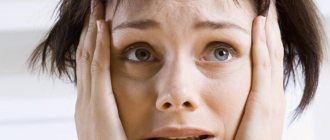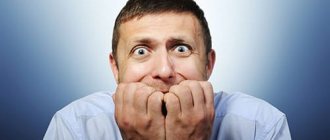Today, many people suffer from attacks of unreasonable panic fear. It can occur suddenly - in the subway, at home, among a crowd of people or completely alone, early in the morning or late at night. Such attacks are called “panic attack” or “vegetative crisis”. In fact, panic attacks and their symptoms are quite diverse, and can manifest differently in different people.
As a rule, at first there is a slight uneasy feeling. Anxiety increases in a matter of minutes - from fear a person cannot move: get up, go outside, go to work. The heart beats faster, the hands sweat, dizziness, headache, nausea, tremors occur, and the arms or legs may even become numb. It seems to a person that he is about to lose consciousness, go crazy, or even die from a heart attack or stroke, and therefore he is afraid to move, so as not to fall in front of many people or, conversely, to be left without help. And so, he can wait for 30-60 minutes until the attack of fear subsides.
“One day I was tinkering with my car in the garage as usual. Suddenly, out of the blue, I felt numbness on the left side of my face and body. I couldn't move, it was like I was paralyzed. At the same time, I began to feel very thirsty - my throat was dry. I felt hot and cold, and I just lay down in the car and waited for it to end. After 30 minutes I was released. From then on, as soon as I approached the car, I felt bad, and if I got behind the wheel, everything swam before my eyes. In the end, I even had to quit my job as a car mechanic,” patient Arthur (46 years old).
It also happens that a person who suddenly has a panic attack, on the contrary, runs as quickly as possible into fresh air because he experiences an acute feeling of suffocation - and this helps him cope with the attack.
Some patients complain that they begin to experience anxiety when faced with a specific situation. For example, when you need to drive or go to work. If a person continues an action that irritates his nervous system, the intensity of the attack increases. If he stops the action and returns home, then the anxiety gradually fades away. Thus, many people who suffer from panic attacks and their symptoms have to quit work, study, and completely change their usual lifestyle. And this method also often helps them to significantly reduce the manifestations of panic disorder, but not get rid of it completely. In addition, not everyone can afford such drastic changes in life.
What to do if you experience regular attacks of panic?
Panic attack symptoms
People with panic disorder very often do not see a doctor for a long time and do not tell their loved ones about the existing problem. As a rule, a person either thinks that there is no problem, and he himself will be able to cope with his poor health, forcibly overcoming all the signs of a panic attack, or he is embarrassed by his “weakness,” or is completely afraid that he will be “sent to a mental hospital.” This is completely unnecessary. However, it is necessary to treat sudden and regular panic fear.
“When I first had a panic attack, I had to call an ambulance. They just gave me glycine and didn't tell me anything else. After that, I went through the entire cardiology center and passed all the tests. I was told that I was absolutely healthy. My family and friends thought I was faking it. I tried not to pay attention to the attacks, reassuring myself that when I came home everything would be fine. Sometimes he deliberately drove himself into a traffic jam in order to overcome his fear. Such a nightmare was happening that you could at least abandon the car and leave. Sometimes I did just that. I would drop my car off at the metro station and come and pick it up the next day. Although before this illness I generally tolerated traffic jams calmly,” patient Pavel (41 years old).
First, let’s look at the symptoms with which you can probably come to the doctor and say: “Doctor, I’m having panic attacks. What to do?"
Psycho-emotional component of a panic attack. Symptoms and signs:
- Sudden, unreasonable attacks of fear/anxiety/panic, lasting from several minutes to several hours
- Waiting for sudden death, waiting for an attack
- Intrusive thoughts (usually related to death)
— Blurred consciousness
- Feeling of derealization (“I am separate, the world is separate”, “the world through cellophane”, “like in an aquarium”)
- Constant feeling of anxiety
— Various phobias (agoraphobia, social phobia, etc.)
— Insomnia, “nightmare” dreams
— Decreased mood, tearfulness
- Irritability, aggressiveness
“In the summer of 2014, I realized that I regularly could not fall asleep until 5-6 o’clock in the morning. The stuffy summer aggravated my condition, I constantly experienced a feeling of lack of air, my heartbeat quickened, obsessive thoughts arose in my head: “What if I’m dying?” - panic grew, but I had no strength to move or call an ambulance. I lay there like that until the morning, when my eyes closed on their own from fatigue and constant tension. This happened several times a week,” patient Elena (28 years old, manager).
Physiological component of a panic attack. Symptoms and signs:
— Dizziness, headache, heaviness in the head, noise in the head/tinnitus
- Lack of air, suffocation, shortness of breath
— Rapid heartbeat, feeling of interruptions in the heart, pain in the heart
- Nausea, abdominal discomfort
- Chills, fever, sweating
- Trembling in the arms, legs, body
- Muscle tension, numbness in limbs
— Gastrointestinal tract disorder
- Feeling tired, weak, lack of strength
“5 years ago I was unsuccessfully treated with antibiotics and after that I started having stomach problems. All these years I suffered from constant diarrhea. I contacted a parasitologist, gastroenterologist, immunologist and other specialists. Tests and clinical studies did not reveal any diseases. I tried to be treated with probiotics and prebiotics, but to no avail. Other symptoms also began to bother me: heaviness in the head, tension in the back and neck, anxiety for no reason, fear for one’s health, sometimes the heart was pounding wildly, in the morning after sleep there was slight dizziness and, of course, constant fatigue and weakness,” patient, Andrey (31 years old).
Important symptoms of panic attacks are also their systematicity and regularity. The interval between panic attacks can vary from a few minutes to several days or months, but their regular occurrence indicates that you are suffering from a panic disorder.
How to recognize?
A sudden feeling of anxiety and fear of death, a feeling as if the heart is jumping out of the chest, lack of air and internal trembling, nausea, vomiting, and most importantly - all this for no apparent reason. This is how a panic attack manifests itself.
“We were at a friend’s dacha, and at night I woke up abruptly with the feeling that my heart was gurgling. It's hard to describe in words. There was great fear, I was trembling all over, it seemed that my end had come. I opened the window, began to breathe and make promises to the whole world - I will quit smoking, drinking, I will start running, just, Lord, let me go.”
Panic attacks often begin suddenly, and those experiencing them for the first time may think it is a heart attack due to rapid heartbeat and chest pain. They can also be similar to anxiety attacks, but experts emphasize that with panic attacks, the main psychological symptom is an intense fear of death.
“It’s like they’re killing me,” shares one user on the social network.
The duration of the attack may be only a few minutes, in other cases it lasts several hours. But on average its duration is 20-30 minutes.
Many admit that because of this they develop many phobias - they are afraid to go out in public, ride the subway, ride in the elevator, fly on an airplane, walk up the stairs. People are beginning to fear confined spaces where there will be no access to help...
Panic attack. Emergency self-help.
First, learn how to manage your panic attacks yourself to control them and reduce the intensity of your panic attack symptoms.
Try practicing breathing techniques.
Breathe through your diaphragm (belly), in through your nose and out through your mouth slowly and calmly. For example, for 5 counts – inhale, for 10 – exhale.
“Some patients benefit from progressive muscle relaxation. If your muscles are very tense during a panic attack, try tightening your facial muscles: tense your jaw for 8 seconds - then relax, tense your lips for 8 seconds - relax. Repeat the exercise with your arms (palms, forearms) and switch to the next muscle group, for example, the calf muscles, the feet. Alternate tension and relaxation of all parts of the body will help relax the muscles and distract thoughts,” recommendations of a neurologist-vegetologist (“Clinical Center for Autonomic Neurology”).
During a panic attack, try to distract yourself and not think about the symptoms that are bothering you. Use psychological techniques. Visualize some place where you felt good: a house, a vacation spot, a cottage, a forest, a sandy beach - whatever your heart desires. And imagine in detail the entire environment that surrounds you there: a soft chair, a fluffy cat, the smell of pine trees, the crunch of branches under your feet, birdsong, warm sand, etc. Think in advance about where it would be better for you to “go” when you have another panic attack in order to distract your thoughts from its symptoms.
Keep a diary of panic attacks that you can refer to in critical situations. This way you can remind yourself that there is nothing to be afraid of, and the next panic attack will soon pass.
Treatment of panic disorders in the Skvira center
If panic attacks are repeated more and more often and interfere with a full life in society, then you cannot do without the help of a professional doctor in such situations. Medical provides services for the treatment of panic disorders. Experienced psychotherapists and psychologists work with patients, using safe and effective techniques: using hypnotherapy, doctors identify and process the first uncomfortable anxiety state:
- Cognitive-behavioral methods in combination with hypnosis allow the patient to quickly learn healthy stereotypes;
- psychocorrection reduces anxiety and tension, normalizes sleep and improves mood;
- psychotherapy strengthens the nervous system and restores the psyche through the transformation of negative emotions and events from the subconscious.
The advantage of treatment at the center is that the main methods of therapy are psychotherapy and psychocorrection, and medications are only an aid.
As a result of the help of psychotherapists, patients’ resistance to stress increases, a positive mood and good sleep are restored, and panic attacks completely disappear.
The technique provides long-term and lasting results, which cannot be said about drug therapy, in particular about the side effects of various drugs and the addiction they cause. During psychotherapy, the patient learns to control and monitor his emotions and thoughts, and gradually changes the beliefs that lead to the development of the disorder. Doctors will help anyone who turns to us for help to find peace, self-confidence and a healthy, harmonious state of mind.
Panic attacks. Difficulties in diagnosis.
People suffering from the symptoms of panic attacks usually do not know where to turn. They visit the offices of a therapist, cardiologist, endocrinologist, psychiatrist, psychologist, but doctors do not detect any disturbances in the functioning of the body. Of course, it is advisable to undergo all possible examinations and pass all the necessary tests in order to exclude the development of serious physiological abnormalities. However, if, in the end, they tell you that you are absolutely healthy, but anxiety, tachycardia, insomnia and other symptoms continue to torment you, then most likely you suffer from panic disorder, which means the problem lies in a disruption of the autonomic nervous system , which can only be identified by an experienced neurologist-vegetologist.
Some patients with signs of panic attacks are diagnosed with vegetative-vascular dystonia (VSD) and told that they will have to live with such symptoms all their lives, alleviating them with medications: antidepressants and tranquilizers.
“I went to all the doctors because there were a lot of symptoms: my heart, shortness of breath, blood pressure, my stomach, bones, muscles ached, I felt constant anxiety. At first, rare panic attacks grew into a daily norm. The neurologist prescribed Coaxil, but the pills made me feel worse. I drank Coaxil for three months and barely got off it. Then the therapist prescribed me adaptol. It made me feel better, but only while I was drinking it, and as soon as I stopped drinking, everything started all over again. Everything was useless until I learned from friends about the “Clinical Center for Autonomic Neurology”,” patient, Arthur (46 years old).
The deep misconception that VSD and panic attacks cannot be treated can be dispelled if you visit a doctor who specializes specifically in disorders of the autonomic nervous system. Panic attacks can be treated and diagnosed! The main thing is to know where and how this can be done.
general information
According to statistics, panic attacks periodically occur in one person out of 20. Young people (age 20-30 years) experience attacks more often than older people, and women more often than men.
The exact mechanism of panic has not yet been identified. Most doctors associate the symptoms with a sharp release of stress hormones into the blood: adrenaline and norepinephrine. As a result, the body turns on the “fight or flight” mode and mobilizes all its forces. A person’s pulse and blood pressure rise, breathing quickens, and a strong feeling of anxiety appears that cannot be suppressed by force of will.
The attacks cause such intense fear that the patient begins to live in anticipation of a new wave of panic. If conditions are repeated periodically, they can cause the development of severe neurosis and depression, completely subjugating a person’s life. Timely help from specialists makes it possible, if not to get rid of attacks completely, then at least to reduce the frequency of their occurrence, and also to learn self-help skills during panic.
Make an appointment
Panic attacks. Modern diagnostic methods.
Only a qualified neurologist-vegetologist can diagnose panic disorder, which manifests itself as panic attacks, identify its symptoms and prescribe optimal treatment.
At the initial examination, the vegetarian doctor must examine the patient’s normal reflexes, his muscular system, sensory organs, cognitive functions (memory, speech, perception), assess the general psycho-emotional state of the patient, taking into account all his complaints in order to collect a complete picture of the disease.
Next, there are several methods for diagnosing autonomic nervous disorder. One of them is the study of heart rate variability.
The patient performs a simple load: first he lies on his back, and after a few minutes he gets to his feet. In this way, we simulate a standard everyday situation when the minimum load is placed on our body. During this time, sensors attached to the patient's chest record the rhythm of his heart, and the doctor then compares the changes in rhythm in both positions. Such a study shows how adapted the human body is to the usual minimum load, which our autonomic nervous system normally copes with every day without the slightest difficulty.
How it works?
In a healthy state, our body responds adequately to any “stress”, any load (mental, physical, emotional). Therefore, when a healthy person gets up, the sympathetic part of the autonomic nervous system is activated in his body and the hormone adrenaline is produced, which means the heartbeat quickens. When a person lies down, his body should normally be in the mood for rest and relaxation. At the physiological level, this manifests itself as follows: the parasympathetic department of the autonomic nervous system becomes active and the hormone acetylcholine is released, which extinguishes the activity of adrenaline, and a phase of relaxation and replenishment of the body’s reserves begins.
But in patients with symptoms of panic attacks, an abnormal change in heart rhythms is observed: that is, when a person lies down, his pulse quickens and becomes faster and faster. That is, when a person gives his body the command to tune in to rest, the body understands the opposite - and prepares to run a short distance race. This is why people with disorders of the autonomic nervous system so often cannot sleep at night and never feel rested and alert.
Thus, the doctor concludes that the harmonious functioning of the sympathetic and parasympathetic parts of the nervous system is disrupted. This means you can move on to the next stage of the examination.
Among the innovative methods for diagnosing panic disorder are studies of the autonomic nervous system using infrared thermography. In an infrared image, a thermal imager clearly shows in which nodes (ganglia) of the autonomic nervous system the work is disrupted. It is with these vegetative nodes that the neurologist-vegetologist will subsequently work.
“Serious scientific research over the last decade has shown the high reliability and reliability of thermography. This allows this method to be used in medical practice to make a diagnosis in complex cases,” James Mercer, Professor, President of the European Thermography Society (EAT).
| Fig. 1 – Thermal image before treatment of panic attacks and VSD – the functioning of the vegetative node in the cervical region is disrupted (colors – red and orange) | Fig. 2 - Thermal image of the same patient after treatment of panic attacks and VSD - the temperature in the vegetative node of the cervical spine has returned to normal (colors - blue and green) |
After treatment, you can take a repeat infrared photo, in which you will notice progress from the completed course. Areas with abnormal temperatures (bright red or dark blue) will change color in the image because their temperature regime is closer to normal.
Methods for treating panic attacks
Lack of awareness among people about panic attacks leads to the fact that some consider the disease incurable, while others are confident that the pathology does not cause any danger. Both opinions are wrong, since with the right approach the disease can be controlled and treated. You just need to seek help from an experienced specialist who, after studying the symptoms and carrying out diagnostic measures, will establish a diagnosis and draw up a treatment regimen.
The main methods of therapy are psychotherapy, psychopharmacology and treatment with folk remedies at home.
Drug therapy
Medications can reduce symptoms, weaken or completely eliminate the panic state. It can be:
- tranquilizers. They relieve acute attacks, but only with long-term use cause dependence;
- antidepressants. They have many contraindications, so you should select a specific product with extreme caution;
- neuroleptics. Prescribed in cases where other medications do not provide the desired effect;
- neurometabolic. Effective drugs, used in courses and only under the supervision of a doctor.
You should pay attention to the fact that each of the medications is prescribed by the doctor personally based on the symptoms and condition of the human body. In case of side effects or other adverse events, medications should be discontinued immediately.
Psychotherapeutic treatment
It is difficult to get rid of panic and anxiety attacks with medications alone. Psychotherapy will help reduce the dosage of medications and eventually stop taking them, while improving the quality of life. Various techniques are used in this direction:
- cognitive-behavioral – reduces the degree of anxiety, models behavior and thinking at the time of an attack, sets the mood for positivity;
- classical and/or Ericksonian hypnosis. The patient is encouraged to get rid of panic disorder. After the sessions, the level of anxiety decreases, self-confidence increases, and panic attacks disappear;
- body orientation therapy. Includes breathing techniques, Jacobson's relaxation and other methods that regulate anxiety levels by influencing the body.
Psychoanalysis and systemic psychotherapy can solve problems with panic attacks and provide a positive effect.
Treatment at home
Professional therapy will be most effective if it is supplemented with treatment at home. Decoctions of oregano, motherwort, young leaves of birch, chamomile, linden and other plants will help reduce fear and panic. Aromatherapy gives positive results; candles with essential oils of juniper, eucalyptus and pine are especially useful.
In addition, while at home, you should minimize the consumption of coffee and strong tea, learn to breathe correctly, with the help of special training of the nervous system, develop resistance to stress, exercise regularly and set yourself up for the positive.
Panic attacks symptoms and treatment
To successfully treat panic attacks, an integrated approach is required; one of the modern treatment methods is complex physiotherapy. The treatment is aimed at the root cause of the disorder, which is rooted in the physiological disruption of the body. Psychotherapy can also be used as a method of treating panic attacks, but only as an auxiliary link. In some cases, a psychotherapist can alleviate the condition and reduce the severity of panic neurosis.
One of the clinics in Moscow that specializes directly in disorders of the autonomic nervous system is the Clinical Center for Autonomic Neurology. The clinic’s doctors have extensive experience working with panic attacks: they know how their symptoms manifest themselves and what treatment will be optimal in a given case. As part of a comprehensive physiotherapy course, you can be offered:
— undergo a course of intravenous laser therapy
— infrared laser therapy
— magnetic therapy
— as well as a course of color pulse correction of suprasegmental autonomic disorders (color therapy)
All methods are aimed at working directly with damaged vegetative nodes.
The targeted effect on the nerve nodes in its effect on the body is reminiscent of acupuncture in oriental medicine (acupuncture), but the action of the laser is much more accurate and is based on science, and not on ancient intuitions, especially since it is supported by thermal imaging images that show the localization of the vegetative node in the human body accurate to the millimeter.
“I underwent 2 courses of acupuncture with symptoms of panic attacks. After the first course, which lasted a month, I felt better - I just sighed. But a month later I had to return. Another month after the second course, my body completely returned to its previous deplorable state. The effect faded away again. Acupuncture gave me only temporary relief. The effect of the laser was incomparably more effective,” patient Alexander (43 years old).
For most patients, it is enough to undergo one course of comprehensive physical therapy to feel significantly better, and after a recovery period that lasts from 4 to 6 months, to completely get rid of all symptoms of panic attacks. In more advanced cases, several courses may be required. However, noticeable improvements are noticeable after the first treatment session.
“During laser therapy sessions, I felt relaxed and even fell asleep. After the first sessions, the anxiety noticeably subsided and my head cleared. Panic attacks after completing the course of treatment became rare and short-lived. There was one case of exacerbation in the subway, but the doctor warned me that this was possible during the recovery period. I happily completed the second course of treatment a year later and now I feel even better than when I didn’t have panic attacks yet,” patient Sergei (34 years old).
Causes of panic conditions
Each person is individual and, accordingly, their diseases are individual. The mechanism of the panic state has not been fully elucidated. But it is known that in the majority
- cases of panic attacks are susceptible to:
- overly impressionable individuals;
- people suffering from a lack of magnesium and zinc in the body. According to research, a deficiency of these substances provokes panic disorders;
- people who have suffered severe psychological shocks;
- genetically predisposed persons whose relatives are prone to nervous or mental disorders;
- people who have experienced sudden stress or are chronically depressed;
- drug or alcohol abusers, as well as gambling addicts .
Along with this, panic attacks are not always caused by panic disorder. They can be triggered by low blood sugar, an overactive thyroid gland, medications as a side effect, and other factors.
Experts distinguish three main types of PA:
- spontaneous - appears suddenly without the presence of any provoking factors;
- situational - occurs when expecting a certain event, for example, before an exam, interview, in anticipation of a conflict;
- conditional-situational - the key factor is a chemical or biological activator. This could be drug or alcohol abuse, hormonal changes.
If you do not treat a panic attack, regardless of the causes and types of the disease, then in a person with such a diagnosis, attacks will only intensify and become more frequent, the quality of life will deteriorate, problems in social adaptation and other negative consequences will arise.
Panic attacks and anxiety: symptoms, is there a difference between these conditions?
There is a feeling of anxiety that arises in connection with a real threat and uncertainty of the situation. In this case, the anxiety goes away when the real threat disappears and the expected situation becomes clear and understandable. But it happens that a person is safe, but anxiety does not go away and goes from being a feeling to a state of anxiety. It seems that everything is fine, everything is working out in life, loved ones are healthy, there are no problems, but anxiety does not disappear and begins to prevent a person from living a full life.
Any condition and personal quality can manifest itself within normal limits and be controlled by a person, or it can intensify to the limits of a borderline state or even turn into the status of a personality disorder.
Borderline states are called neurosis. This means that anxiety can reach a level of intensity at which a person can no longer control it, and at the same time, disruptions appear at the level of body and behavior.
When anxiety increases excessively, panic attacks may occur, which are accompanied by a feeling of fear and even panic.
Symptoms of panic attacks:
- high level of anxiety, turning into a feeling of fear;
- experiences of fear of death, loss of health, going crazy;
- feeling of suffocation, increased heartbeat, pulsation in the temples;
- periods of chills followed by fever;
- tremor of fingers/whole body.
Panic attacks can occur in connection with a specific situation (for example, a trip on the subway), for no reason or under the influence of chemicals (alcohol, drugs, intoxication), hormonal changes. These conditions are felt as severe, painful, and over time, the fear of panic attacks arises, which provokes another attack.
Mistakes patients make in treating panic attacks
Self-medication is a major problem for people who experience periodic anxiety attacks. This approach often aggravates the condition and leads to the development of complications. Recovery in such patients requires a more in-depth approach and will be longer. Self-administration of psychotropic medications can lead to the formation of a chronic process, and such a disease is always less treatable.
Modern techniques
We provide supervision in various forms, depending on the wishes of the patient and his objective condition, both in a day hospital, an extended day hospital, and on an outpatient basis. We do not believe in miracles, we treat panic attacks even if previous treatment did not help, the most complex disorders of the psychological spectrum with the help of science and our experience.
Help with anxiety disorders and panic attacks for loved ones of addicts and co-dependent people
Step 1. Consultation with a psychiatrist in order to establish or exclude endogenous and other pathological causes of the development of panic attacks. If necessary, medicinal correction.
Step 2. Consultation with a clinical psychologist for the purpose of pathological examination, determination of emotional and personal characteristics of the individual and social situation (stressful situations).
Step 3. Systematic work with a psychologist in order to work through negative emotional states, unconscious conflicts, attitudes, prescriptions, as the causes of anxiety and panic attacks, using various methods, the most effective of which is emotional-imaginative therapy.
Emotional imagery therapy is a well-proven method for working with anxiety and panic attacks. With the help of special exercises and techniques, the client works through his condition, internal conflicts, that is, the reasons that underlie these conditions. The method of emotional-imaginative therapy is safe and environmentally friendly, allowing you to achieve a positive and sustainable result in a fairly short time.
Help with anxiety disorders and panic attacks for alcohol and drug addicts
In this part of the article, we will look at specific steps for working with anxiety and panic attacks in addicted and co-dependent people.
Step 1. Help from a narcologist to relieve withdrawal symptoms and restore physical functions of the body.
Step 2. Consultation with a psychiatrist to determine the degree of “destruction” of brain functioning as a result of drug or alcohol use; the presence or exclusion of concomitant endogenous diseases that can cause panic attacks (depression, for example); selection of treatment, support and correction of treatment if necessary.
Step 3. Consultation with a clinical psychologist for the purpose of a pathodiagnostic examination of the addict and clarifying the diagnosis made by the psychiatrist, excluding other mental disorders, determining the characteristics of the emotional and personal sphere of the addict and his social situation.
Step 4. Work with a psychologist for the purpose of recovery under a program for addicts in an inpatient or outpatient setting, working through the internal causes of anxiety and panic attacks (unconscious conflicts, attitudes, parental instructions).









